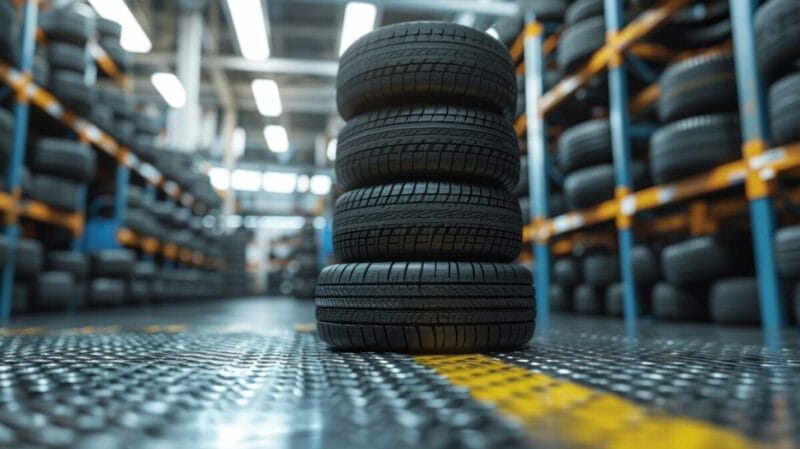The Complete Guide: How Is a Tire Made – From Raw Materials to Finished Product
At City Tire, we offer exceptional service to our customers and how they service their vehicles. Our customers often ask about our tire services which include tire rotation, balancing, and alignment . If you need help with your tires do not hesitate to contact us. Our locations throughout Ohio can help monitor you with any tire issue you are having.
Introduction to Tire Manufacturing
Tires are an essential component of any vehicle, playing a crucial role in ensuring safety, performance, and efficiency on the road. Understanding the tire manufacturing process is vital for car owners, as it provides insights into the quality, durability, and performance of the tires they use. Whether it’s maintaining the right air pressure, heat resistance, or understanding the impact of tire materials on the environment, delving into the intricacies of tire manufacturing offers valuable knowledge for both car owners and professionals in the automotive industry.

Raw Materials Used in Tire Manufacturing
Rubber as the Primary Raw Material
Rubber, specifically natural rubber and synthetic rubber, serves as the fundamental raw material in tire manufacturing. Natural rubber is derived from the latex of rubber trees, while synthetic rubber is produced from petroleum-based chemicals. These rubber materials provide the necessary elasticity, flexibility, and resilience required for tires to withstand various road conditions and temperatures.
Other Essential Materials
In addition to rubber, tires also incorporate other essential materials such as fabric, steel, and various chemicals. Fabric, typically polyester or nylon, is used for the body plies and belts within the tire to provide strength and stability. Steel is utilized for the tire belts and bead wire to enhance the tire’s structural integrity. Chemicals like carbon black are added to the rubber compound to improve wear resistance and overall durability.
Sustainable and Eco-friendly Options
Tire manufacturers are increasingly exploring sustainable and eco-friendly raw material options to reduce the environmental impact of tire production. This includes the use of bio-based rubber, recycled rubber, and eco-friendly chemicals in tire manufacturing, aligning with global efforts to minimize air, soil, and water pollution.
The Tire Production Process

Compounding: Mixing the Raw Materials
The tire manufacturing process begins with compounding, where the raw materials such as rubber, carbon black, and various chemicals are mixed together to form the rubber compound. This compound is then processed to achieve the desired properties such as tread wear, traction, and heat resistance.
Tire Building: Constructing the Tire Layers
Once the rubber compound is ready, the tire building process commences. This involves assembling the various components such as body plies, belts, and tread patterns to construct the tire layers. The precise arrangement and alignment of these components are critical in determining the tire’s performance characteristics.
Curing: Vulcanizing the Tire
Curing is a crucial stage where the green tire, assembled during the tire building process, undergoes vulcanization. This process involves subjecting the tire to heat and pressure in a curing mold, allowing the rubber to cross-link and solidify, resulting in the final tire shape and structure.
Inspection and Testing: Ensuring Quality and Safety Standards are Met
After curing, the tires undergo rigorous inspection and testing to ensure they meet quality and safety standards. This includes checks for dimensional accuracy, uniformity, balance, and various performance tests to validate the tire’s durability, traction, and resistance to air pressure loss.
Quality Control and Safety Standards
Importance of Quality Control in Tire Manufacturing
Quality control is paramount in tire manufacturing to ensure that every tire meets the required performance and safety standards. Stringent quality control measures are implemented throughout the production process to identify and rectify any defects or inconsistencies, ultimately delivering reliable and high-quality tires to consumers.
Regulatory Standards and Certifications
Tire manufacturers adhere to regulatory standards and certifications set by organizations such as the Tire Manufacturers Association and government regulatory bodies. These standards encompass aspects like tire identification number (TIN), load and speed ratings, and labeling requirements to provide consumers with essential information about the tires they purchase.
Ensuring Safety and Performance through Rigorous Testing
Tire manufacturers conduct extensive testing to evaluate the safety and performance of their products. This includes testing for traction on different road surfaces, tread wear, heat resistance, and air pressure retention to ensure that the tires perform optimally in various driving conditions while maintaining safety standards.
Innovations and Future Trends in Tire Manufacturing

Advancements in Sustainable Materials and Manufacturing Processes
The tire industry is witnessing significant advancements in sustainable materials and manufacturing processes. This includes the development of bio-based and recycled materials, as well as innovative manufacturing techniques aimed at reducing energy consumption and waste generation, contributing to a more sustainable and eco-friendly tire production.
The Impact of Technology on Tire Production
Technology plays a pivotal role in modern tire manufacturing, with advancements in automation, data analytics, and artificial intelligence optimizing production processes and enhancing product quality. Additionally, the integration of technology in tire design and development is leading to the creation of tires with improved fuel efficiency, performance, and safety features.
Future Trends and Developments in the Tire Industry
The tire industry is evolving to meet the demands of a rapidly changing automotive landscape. Future trends include the development of smart tires with integrated sensors for real-time monitoring of air pressure, temperature, and tread wear, as well as the exploration of innovative materials and designs to enhance tire performance and sustainability.
Conclusion
Understanding the tire manufacturing process provides valuable insights into the complexity and precision involved in producing high-quality tires. From the selection of raw materials to the meticulous production stages and rigorous quality control measures, tire manufacturing encompasses a blend of science, technology, and engineering expertise. As consumers, having a comprehensive understanding of how tires are made empowers us to make informed decisions when purchasing and maintaining tires, ultimately ensuring safety, performance, and longevity on the road.
In conclusion, tire manufacturing plays a pivotal role in various industries, from automotive to transportation, and its significance extends to environmental sustainability and safety standards. By staying informed about tire manufacturing processes and industry developments, we can contribute to a safer, more efficient, and environmentally conscious future on the road.

 Find a Location Near You
Find a Location Near You
